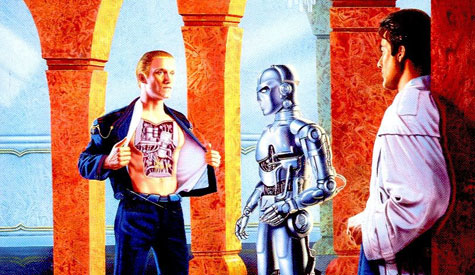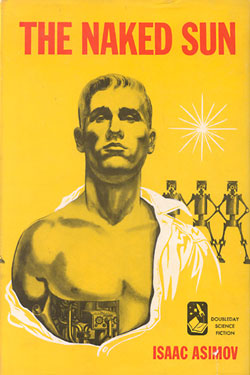
A few months after solving an ambassador’s murder and receiving accolades from across the known universe (where fifty other inhabited planets exist), Elijah Baley is summoned from New York to the Department of Justice in Washington, D.C. for a top secret case.
It was hard enough for the agoraphobic, aviophobic, and a host of other phobias detective to have made the plane trip, but now he’s given a new assignment, on the planet Solaria in the Outer World, where he is to investigate another homicide while spying on the closed-off world. Neither task will be easy for Baley, since the place is teeming with a population of ten thousand robots for every human—Big Brother is everywhere and he’s still working through his bigoted views of robots. But before you can say Buck Rogers, he’s on an interstellar flight, bound for Solaria.
In a welcoming surprise, he is re-partnered with Robot Daneel Olivaw, who assisted him on the ambassador case, and for a machine-wary person, Baley has a damn near euphoric response upon seeing his humaniform counterpart—or maybe it was the white-knuckle rocket trip.
Baley hoped earnestly that the creature’s unreadable eyes could not penetrate Baley’s mind and see that wild moment, just past and not yet entirely subsided, when all of Baley had concentrated into a feeling of an intense friendship that was almost love.
 Yeah, there are several roll-of-the-eye passages like this where Isaac Asimov seems to awkwardly emote, but some quirks needn’t be examined too closely since it still works—we’ve already come to care about the contrariant pair after reading about all they went through in their first adventure, The Caves of Steel. The exploits persist in The Naked Sun, with Daneel doing his best to provide a “safe,” clean environment for germophobe Baley, unwittingly thwarting his human partner’s attempt to uncover data about Solaria. And Baley continues to evolve, recognizing in Daneel’s mechanical traits are qualities that far outshine many humans he knows.
Yeah, there are several roll-of-the-eye passages like this where Isaac Asimov seems to awkwardly emote, but some quirks needn’t be examined too closely since it still works—we’ve already come to care about the contrariant pair after reading about all they went through in their first adventure, The Caves of Steel. The exploits persist in The Naked Sun, with Daneel doing his best to provide a “safe,” clean environment for germophobe Baley, unwittingly thwarting his human partner’s attempt to uncover data about Solaria. And Baley continues to evolve, recognizing in Daneel’s mechanical traits are qualities that far outshine many humans he knows.
But, reading Asimov in the 21st century isn’t about interpersonal relationships or technological passages that are now dated (though he deserves big props for getting items like holographic images and driverless cars more or less right). It’s the bigger picture of where we are headed as a species, how our enduring racial views stagnate us, and what needs to be done to overcome. Sadly, if anything, we have seemed to have gotten a lot closer, a lot faster, to Asimov’s dystopian future than the author anticipated in the 1950s. Like Solaria, we have a vast amount of technology but are growing more isolated, sealed off. Think of the thousands of “friends” many of us have on social media that we’ll never meet face to face, though our next-door neighbors are strangers.
The latest murder victim is Rikaine Delmarre, a fetologist, bludgeoned in his vast estate where he lived alone. Culturally, robots aside, Solarians don’t have physical contact with others, from birth, and only on rare occasion with their pre-selected spouses. They visit through “viewing” each other in lifelike “trimensional image,” which are so real that, at first, the system fooled Baley, who thought he had been face to face with a Solarian.
Robots are quickly ruled out as having been able to kill Rikaine based on The Three Laws of Robotics, which are:
A robot may not injure a human being or, through inaction, allow a human being to come to harm.
A robot must obey the orders given it by human beings except where such orders would conflict with the First Law.
A robot must protect its own existence as long as such protection does not conflict with the First or Second Laws.
So, it’s a foregone conclusion that no machine murdered Rikaine (one found at the scene was “gutted” and was only eerily able to repeat, “You’re going to kill me—You’re going to kill me—You’re going to kill me…”) and no one visited Rikaine, physically, outside his wife Gladia.
Baley and Daneel interview Gladia first, and after an uncomfortable moment where the detectives see her nude (which Daneel calculates was done on purpose), she doesn’t react well to the Earthman’s typical hard-boiled questioning or the horrific scene she had witnessed.
She had never seen a dead body before. She had never seen blood and a crushed skull. And if the husband-wife relationship on Solaria was something thin and shallow, it was still a dead human being with whom she had been confronted.
Baley rules out Gladia based on sound questioning and the fact that no murder weapon was found (leaving one heck of a locked room mystery, Sherlock). He wonders why the Solarian hierarchy would want his aid to begin with, since they are paranoid about contracting Earth human germs—Solarians wear long sleeves in the presence of others, they refuse to shake hands, and they even wear nose filters.
It’s explained to Baley that this is the first crime of violence in two centuries of Solarian history and, though they have a head of security, Hannis Gruer, there is no police force to speak of, so an earthling’s expertise is necessary. Still, Baley wisely begins to suspect there’s some other reason he and Daneel have been summoned.
An answer, of sorts, comes when Gruer confides to Baley that Rikaine cryptically told him there was a cosmic threat to the entire universe. No sooner than Baley receives this clue, Gruer is poisoned. Once again, all avenues of approach to Gruer’s murder, like Rikaine’s, leave more questions than answers.
Isaac Asimov’s dialogue and theatrics is mawkish at times, and the repetition of certain words like “queer” (original denotation) and “Jehoshaphat” (in place of profanity) is overly distracting. In addition, he may have known robots, but his female characters in both The Caves of Steel and The Naked Sun lack any kind of “tridimensional” depth—Gladia comes across as a cliché double shot of Vivian and Carmen Sternwood from Raymond Chandler’s The Big Sleep.
However, the scales weigh predominately in the positive. Asimov's tech is retro-cool and the Daneel-Baley chemistry emotionally grounds these adventures. Plus, the central mystery—akin to Agatha Christie’s whodunit brilliance—should leave any locked room puzzle aficionado scratching their head. Above all, The Naked Sun is a lot of fun to read.
See also: R. Is for Robot: Reviewing The Caves of Steel by Isaac Asimov
Images via Wikipedia & Bookstation.hu
To learn more or order a copy, visit:
opens in a new window![]() opens in a new window
opens in a new window![]() opens in a new window
opens in a new window![]() opens in a new window
opens in a new window![]()
David Cranmer aka Edward A. Grainger is the publisher and editor of BEAT to a PULP books and author of The Drifter Detective #7: Torn and Frayed. He lives in New York with his wife and daughter.

Fine review, David.
Appreciate you stopping by, Oscar.
Sri Lanka scored 170-6 off their 20 overs, set up by Bhanuka Rajapaksa’s unbeaten 71 from 45 balls.